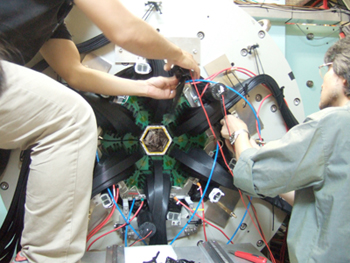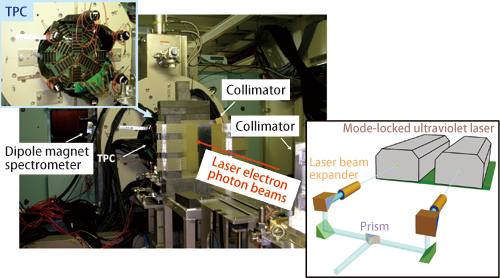Nuclear Physics
Unraveling the Extreme Fundamentals of Materials Using High-Energy Photon Beams

Exploring Quarks using Laser Electron Photon Beams with the World's Shortest Wavelength
At SPring-8, scientists are conducting research on quark nuclear physics. A quark is an elementary particle, which constitutes hadrons such as proton and neutron. Although quarks are always confined in hadrons, the confinement mechanisms, confinement states, and mass acquiring mechanisms of hadrons whose masses are heavier than the sum of the constituent quarks have yet to be elucidated. Quark nuclear physics research aims to reveal these mysteries. The potency of laser electron photon beams, which are produced by revolutionary methods, has been confirmed. Laser electron photons, also called laser inverse Compton photons, are highly energetic photon beams obtained from the recoil of laser light by electron beams.
A research group, Laser Electron Photon at SPring-8 (LEPS), which is led by researchers at the Research Center for Nuclear Physics, Osaka University, is conducting nuclear experiments at SPring-8. Their research uses laser electron photon beams (maximum energy: 2.4 GeV)1) produced by head-on collisions of ultraviolet laser light (3.5 eV, 350 nm)2) and electron beams in a storage ring (8 GeV).
Because photon energy and wavelength are inversely related, amplifying the photon energy seven million-fold from 3.5 eV to 2.4 GeV shortens the photon wavelength seven million-fold from 350 nm to 0.5 fm3). To generate laser electron photon beams, the following are indispensable: high-intensity high-energy electron beams with stable orbits, a high-intensity laser, and the technology to ensure precise collisions. Laser electron photon beams obtained at LEPS have the world's highest energy (shortest wavelength).
Although a 0.5-fm wavelength is very short, it is still about the same size as a nucleon such as a proton and neutron. Therefore, it is impossible to directly observe (in its normal meaning) nucleons or quarks in nucleons with a 2.4-GeV laser electron photon. It should be noted that the particle nature of light (a packet of pure energy or a photon), which exhibits wave-particle duality, is more important than the wave nature of light when examining the quark world.
At the LEPS facility, more than 106 photons are produced per second, and these photons are irradiated onto targets such as hydrogen and nuclei. A photon, which is a packet of energy, changes its form into various types of charged particle-antiparticle pairs in nuclei to induce photonuclear reactions. There are six types of quarks: up, down, strange, charm, bottom, and top quarks. Protons and neutrons, which constitute a nucleus, consist of up quarks and down quarks. A 2.4-GeV photon can produce strange quark-antistrange quark pairs where a strange quark is much heavier than the up and down quarks found in protons and neutrons.
Composite particles composed of multiple quarks, including strange quarks, are termed hyperons. Hyperons have extremely short lifetimes (< 10-20 sec) and decay immediately; therefore, it is difficult to detect hyperons themselves. However, investigating the production and decay of such short-lived hyperons may elucidate the quark confinement mechanism.
1) 1 GeV = 109 eV
2) 1 nm = 10-9 m
3) 1 fm = 10-15 m
Shattering Common Notions and Making the Impossible Possible
With the expectation that the quark confinement mechanism can be solved, a five-quark particle, which consists of an antistrange quark and four normal quarks, was first discovered at LEPS.
The photon beams produced by bremsstrahlung using existing electron beams cannot achieve high-spin polarization. However, a laser electron photon has the following three advantages.
(1) Spin-polarized high-energy photon beams can be easily produced using linearly or circularly polarized laser light.
(2) Photon beams contain a very small amount of low-energy components (< ~100 MeV)4) , which are noise sources in nuclear and elementary particle experiments.
(3) Because photon beams are highly directional, compact detector systems can be used.
In the hadron world, interactions between hadrons are mediated by the exchange of particles; herein many particles can be involved, which complicates the analysis of the experimental data. However, some information about exchanged particles can be determined by examining the angular correlations between the direction of photon polarization and the angular distribution of the mesons emitted in the hadron production. Because single quarks cannot be extracted from hadrons, the capability of examining the hadron production processes by detecting such observables (angular correlations) would be a great advantage in the study of hadron structures. Thus, characteristics that make analyses difficult are converted into powerful clues for the analyses. In this way, the studies conducted at LEPS have redefined the common understanding of quarks.
The intensity of laser electron photon beams is proportional to that of the incident laser. Over the last ten years, the intensity of laser electron photon beams at LEPS has been increased several-fold through the top-up operation where the losses in the electron beams in a storage ring are compensated as necessary, improvement of the laser oscillators themselves, and utilization of parallel injections where two lasers are simultaneously injected. Our future goal is to realize higher energy laser electron photon beams by developing a new laser with an even shorter wavelength. These technologies will be powerful weapons to decipher the mysteries of quarks.
4) 1 MeV = 106 eV

Fig. 1. Schematic diagram of the region where the electron beams in a storage ring and laser collide.

Fig. 2. Charged particle detector and its adjustment.

Entire view of the experimental apparatus (bottom) and time projection chamber (TPC, top). Schematic diagram of a two-laser parallel injection system (right).